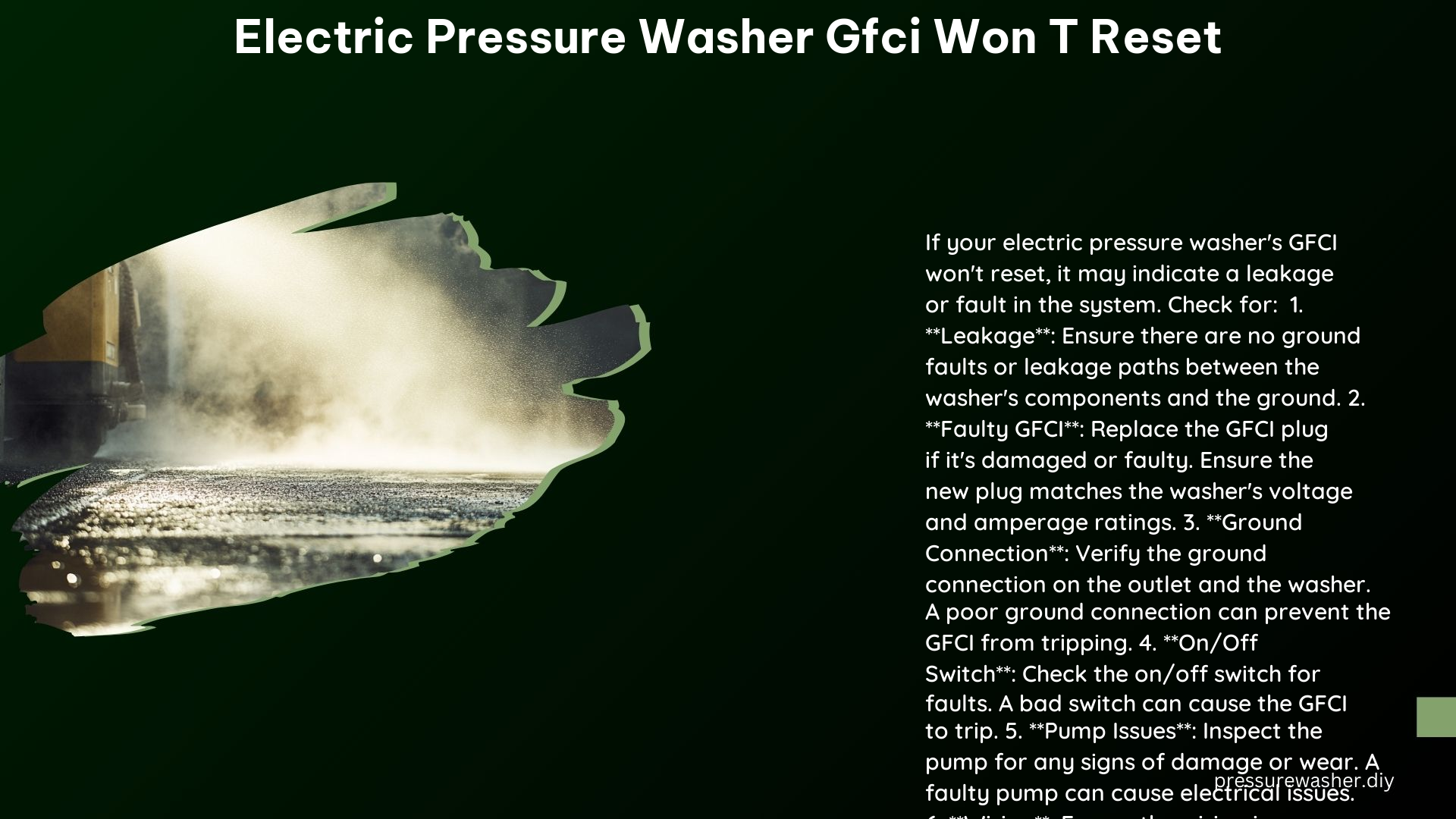If your electric pressure washer’s GFCI (Ground Fault Circuit Interrupter) plug keeps tripping and won’t reset, it can be a frustrating and potentially dangerous issue. Understanding the common causes and solutions can help you troubleshoot and fix the problem effectively.
Causes of GFCI Tripping
1. Faulty GFCI Plug
The GFCI plug itself might be damaged or faulty, causing it to trip continuously. GFCI plugs are designed to detect ground faults and interrupt the circuit to prevent electric shocks. If the GFCI plug is malfunctioning, it will trip the circuit even in the absence of a ground fault.
Technical Specifications:
– GFCI plugs for electric pressure washers typically have a rating of 15 amps and 125 volts.
– The GFCI plug contains a sensitive circuit that monitors the current flow and trips the circuit if it detects a ground fault.
– Common causes of GFCI plug failure include physical damage, water intrusion, and internal component degradation over time.
2. Grounding Issues
A current path between the neutral and ground can cause the GFCI to trip. This can happen if the pressure washer is not properly grounded or if there is a current leak to ground.
Technical Specifications:
– Proper grounding is essential for the safe operation of electric pressure washers. The ground wire should be connected to a reliable ground source, such as a grounded electrical outlet or a metal ground rod.
– Current leaks to ground can occur due to damaged or worn electrical components, improper wiring, or moisture intrusion.
– The GFCI is designed to detect these ground faults and trip the circuit to prevent electric shocks.
3. On/Off Switch Issues
A faulty on/off switch can also cause the GFCI to trip. If the switch is not functioning correctly, it can create an electrical path that the GFCI interprets as a ground fault.
Technical Specifications:
– The on/off switch in an electric pressure washer is responsible for completing the electrical circuit and allowing the motor to operate.
– A worn, damaged, or malfunctioning switch can create a path for current to flow in an unintended manner, triggering the GFCI.
– Replacement on/off switches for electric pressure washers typically have a rating of 15 amps and 125 volts.
4. Pump or Motor Issues
Problems with the pressure washer’s pump or motor can create electrical leaks, leading to GFCI tripping. Damaged or worn components can allow current to flow to ground, causing the GFCI to interrupt the circuit.
Technical Specifications:
– Electric pressure washers typically have a motor that powers the pump, which generates the high-pressure water stream.
– The motor and pump are critical components that can be affected by wear, damage, or moisture intrusion, leading to current leaks.
– Motor and pump specifications vary by pressure washer model, but they generally have voltage and amperage ratings that match the GFCI plug.
Solutions

1. Replace the GFCI Plug
If the GFCI plug is faulty, replace it with a new one. Ensure that the replacement plug matches the specifications of the original, typically 15 amps and 125 volts.
2. Check Grounding
Verify that the pressure washer is properly grounded and that there are no current leaks to ground. Inspect the ground wire connection and ensure it is secure and connected to a reliable ground source.
3. Inspect and Replace the On/Off Switch
If the on/off switch is faulty, replace it with a new one that matches the specifications of the original switch.
4. Inspect the Pump and Motor
Carefully inspect the pump and motor for any signs of damage or wear. If issues are found, consider replacing the affected components.
Additional Tips
- Always follow safety guidelines when working with electrical appliances, especially around water.
- Ensure the pressure washer is used on a GFCI-protected outlet, as required by the National Electric Code (NEC).
- If you are not comfortable with electrical repairs, consider consulting a professional electrician.
Technical Specifications
- GFCI Plug Specifications: 15 amps, 125 volts
- Pressure Washer Specifications: Varies by model, but typically includes voltage (120V or 240V), amperage (15-20 amps), and pressure ratings (1,000-3,000 PSI)
References
- YouTube. (2021). Electric Pressure Washer won’t start – replacing GFCI plug. Retrieved from https://www.youtube.com/watch?v=ARFefRZzNa4
- YouTube. (2023). Electric Pressure Washer Repair (GFCI plug replacement). Retrieved from https://www.youtube.com/watch?v=1Pzy1Dn0JCg
- JustAnswer. (2009). How to Reset Your Pressure Washer – Troubleshooting Guide. Retrieved from https://www.justanswer.com/small-engine/2bakb-does-electric-pressure-washer-not-work-when-press.html
- Reddit. (2019). I have an electric pressure washer with a GFCI plug, and all… Retrieved from https://www.reddit.com/r/electricians/comments/bzltrp/i_have_an_electric_pressure_washer_with_a_gfci/
- Garage Journal. (2020). Pressure washer GFCI issues. Retrieved from https://www.garagejournal.com/forum/threads/pressure-washer-gfci-issues.452743/
